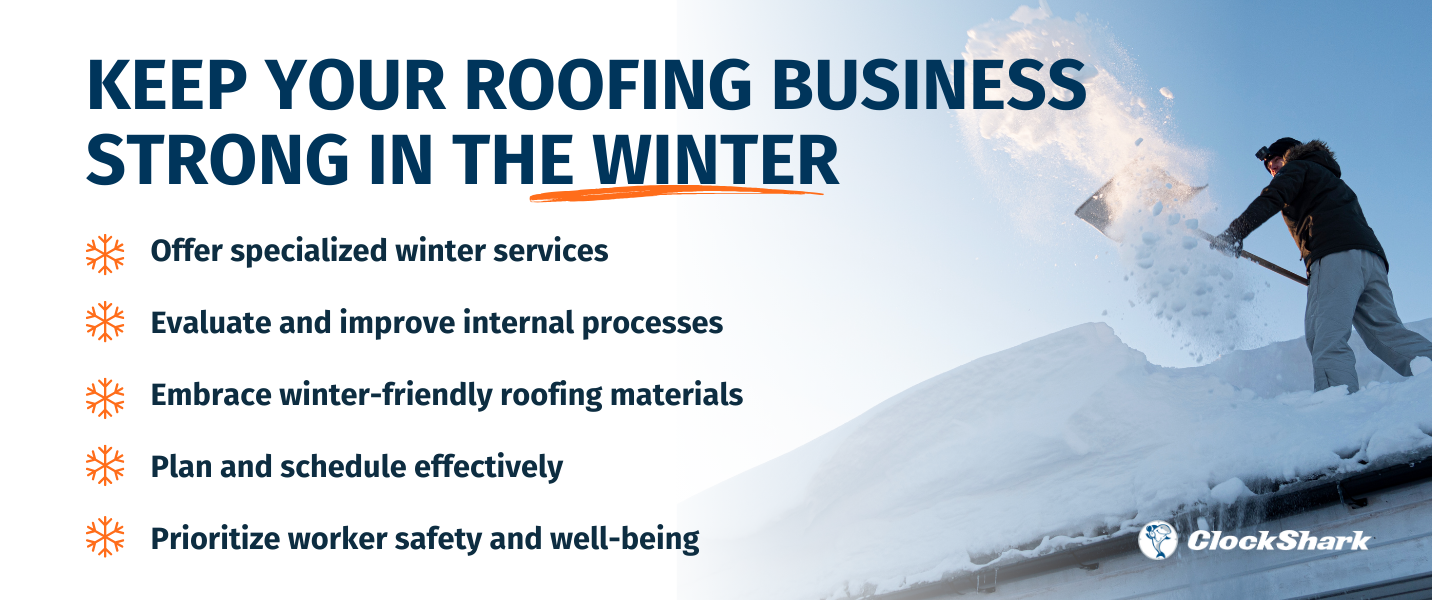Winter roofing is tricky.
Asphalt shingles won’t self-seal when it’s below 40°F. In freezing temperatures, they become brittle and break easily. Nail guns freeze up. Air compressors stall, and ice and snow make working at heights even more risky.
While most winter roofing challenges have workarounds, many are labor and time-intensive. (Think hand-applying four dots of roofing cement to the underside of every asphalt shingle when temperatures fall to 39°F.)
So, unless you live in a region where winters are warm (or it stays frigid year-round), the costs and risks of roofing in cold weather may outweigh the benefits.
But there are things you can do to maximize productivity—and profits—in the off-season.
5 strategies to keep your roofing business strong in winter
Use these strategies to keep your roofing company productive and your business going strong this winter.
1. Offer specialized winter services
Home and business owners need specialized services during the winter. Many are roofing-adjacent. So, you already have the crews and equipment it takes to get these jobs done.
Offer these services to meet wintertime needs and keep your cash flowing:
Holiday light installation and take down
Hanging lights isn’t practical for some home and business owners. Health problems or age can make it impossible for them to climb ladders and work at heights. Or they may just be too busy to do it themselves.
Plus, they might not know how to hang lights correctly. So, a self-install could damage the roof and gutters or pose a fire hazard.
Offering holiday light installation services helps clients avoid potential disasters while helping you boost winter revenue.
Snow and ice dam removal
When snow gets too heavy or ice dams form, it strains roofs and can cause leaks, structural issues, or even collapse.
Educate clients on these dangers and offer your expert snow and ice dam removal services as a solution. Not only will you help people protect their roofs in winter, but you will also become a trusted name in your community.
Emergency repairs
When home or business owners experience urgent winter roofing problems, be the roofer that provides fast service and prevents further damage. When it’s time for a full roof replacement, customers will remember you. And they’ll recommend your services to others in the meantime.
2. Evaluate and improve internal processes
During the busy season, it’s easy to see which systems and processes aren't working—but it’s hard to find enough time to make changes. So, schedule time in the winter to reevaluate and strengthen your business.
Analyze past projects
Make it a priority in the winter to evaluate past experiences to find what works and what doesn't. Address any bad habits that may have developed over time. Decide if new measures are needed to maximize productivity, improve safety, and enhance your company culture.
Train your teams
Make the most of the quieter months by training your teams. Get certifications from roofing manufacturers and implement team-building activities to strengthen relationships and enhance workplace culture.
Experiment with software
Winter is a great time to try out new software for the upcoming year—or learn more about the software you already use.
Organize warehouses and maintain equipment
It’s easy to put off maintenance and organization tasks when things are busy. Use the winter slowdown to perform overdue maintenance on tools, equipment, and trucks. Clean and inventory your shop, and check that your warehouse is fully stocked and well-organized.
Ramp up marketing activities
Advertise now to fill your warm-weather roster. Roofs stressed during the winter often start leaking when the weather thaws. Marketing your roofing services now will keep you top of mind when people need you.

3. Embrace winter-friendly roofing materials
When you do need to work in the cold and snow, use tools and materials that work well for cold-weather installs, like these:
- Polymer-modified shingles: The added polymer in these asphalt shingles improves their flexibility in the cold. They don't crack and can adhere, even in cold conditions. Some brands can be installed at temperatures as low as 0°F.
- Pre-cut ridge cap shingles: Precut ridge cap shingles don’t require cutting or folding, which reduces the likelihood of cracking or breaking in the cold.
- Metal roofing systems: Most metal roofing systems can be installed at subzero temperatures.
- Liquid-applied membranes: These roofing systems can be installed in temperatures as low as -20°F.
- Roof-measurement software: This software uses satellite, aerial, and drone images to let you figure out precise roof measurements, including angles and pitch, without having to climb a ladder or clear snow off roofs.
4. Plan and schedule effectively
Harsh winter weather can significantly impact project timelines. Keep close tabs on weather forecasts, and be ready to change tasks quickly if bad weather is expected.
Plan full roofing jobs when the forecast calls for several consecutive days of good weather. Save less temperature-sensitive tasks for periods of frigid cold.
You’ll also have to plan for shorter workdays since there's less daylight in the winter. To use daylight wisely, schedule tasks that require optimal conditions during the warmest and brightest hours of the day.
Remember, ladders and decks can still be cold and slick even when it's sunny outside. So, workers will have to slow down and take extra precautions, and winter roofing jobs will take longer to complete than warm-season jobs. Build plenty of extra time into your projects to account for this.
And never put a project’s timeline above your workers’ safety.
5. Prioritize worker safety and well-being
While it’s important to keep jobs moving when possible, taking care of your team’s health and safety is more important.
Here’s how to keep roofing crews safe in the winter:
- Conduct weekly safety meetings that focus on staying safe in cold conditions.
- Educate workers on how to dress for the cold by dressing in layers and wearing non-slip boots.
- Ensure workers take plenty of breaks in heated areas to avoid cold stress, hypothermia, and dehydration.
- Perform daily winter hazard checks.
- Show crews how to spot black ice on walking surfaces, ladders, and roofs.
- Use safety gear and fall protection devices to prevent dangerous slips and falls.
To help ensure your team stays safe as they work, ClockShark lets you assign clock-out questions to specific teams or jobs. Crews are required to answer these questions before they clock out. Use them to confirm crews are taking rest breaks, removing onsite hazards, and adhering to safety protocols.
Learn more about ClockShark’s Clock Out Questions.








